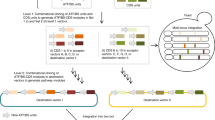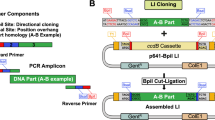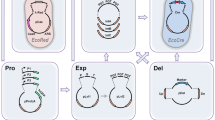Abstract
Structural and functional studies of many multiprotein complexes depend on recombinant-protein overexpression. Rapid revision of expression experiments and diversification of the complexes are often crucial for success of these projects; therefore, automation is increasingly indispensable. We introduce Acembl, a versatile and automatable system for protein-complex expression in Escherichia coli that uses recombineering to facilitate multigene assembly and diversification. We demonstrated protein-complex expression using Acembl, including production of the complete prokaryotic holotranslocon.
This is a preview of subscription content, access via your institution
Access options
Subscribe to this journal
Receive 12 print issues and online access
$259.00 per year
only $21.58 per issue
Buy this article
- Purchase on Springer Link
- Instant access to full article PDF
Prices may be subject to local taxes which are calculated during checkout



Similar content being viewed by others
References
Rual, J.F. et al. Nature 437, 1173–1178 (2005).
Charbonnier, S., Gallego, O. & Gavin, A.C. Biotechnol. Annu. Rev. 14, 1–28 (2008).
Fitzgerald, D.J. et al. Nat. Methods 3, 1021–1032 (2006).
Tan, S., Kern, R.C. & Selleck, W. Protein Expr. Purif. 40, 385–395 (2005).
Tolia, N.H. & Joshua-Tor, L. Nat. Methods 3, 55–64 (2006).
Chanda, P.K., Edris, W.A. & Kennedy, J.D. Protein Expr. Purif. 47, 217–224 (2006).
Scheich, C., Kümmel, D., Soumailakakis, D., Heinemann, U. & Büssow, K. Nucleic Acids Res. 35, e43 (2007).
Kambach, C. Curr. Protein Pept. Sci. 8, 205–217 (2007).
Penfold, R.J. & Pemberton, J.M. Gene 118, 145–146 (1992).
Li, M.Z. & Elledge, S.J. Nat. Methods 4, 251–256 (2007).
Abremski, K., Hoess, R. & Sternberg, N. Cell 32, 1301–1311 (1983).
Gaiser, F., Tan, S. & Richmond, T.J. J. Mol. Biol. 302, 1119–1127 (2000).
Duong, F. & Wickner, W. EMBO J. 16, 2757–2768 (1997).
Bieniossek, C. et al. Proc. Natl. Acad. Sci. USA 103, 3066–3071 (2006).
Berger, P., Schaffitzel, C., Berger, I., Ban, N. & Suter, U. Proc. Natl. Acad. Sci. USA 100, 12177–12182 (2003).
Acknowledgements
We thank R. Jaussi and D. Hart for helpful suggestions, the members of the Berger and Schaffitzel laboratories for discussions and technical assistance, S. Trowitzsch (Max Planck Institute, Göttingen) and the scientists at the Partnership for Structural Biology in Grenoble for providing cDNAs and advice. M.O.S. and T.J.R. are supported by the Swiss National Science Foundation. C.R. and I.B. are supported by the European commission projects Structural Proteomics In Europe 2Complexes (SPINE2C) (European Commission (EC) FP6) and European Infrastructure for Structural Biology INSTRUCT (EC FP7). I.B. is also supported by the Centre National de la Recherche Scientifique (CNRS) and the European commission projects 3D-Repertoire (EC FP6) and Protein Production Platform Pcube (EC-FP7).
Author information
Authors and Affiliations
Corresponding authors
Ethics declarations
Competing interests
I.B. is inventor on a patent application describing the Acembl technology presented here (European patent application EP 09 154 567.3).
Supplementary information
Supplementary Text and Figures
Supplementary Figure 1, Supplementary Results, Supplementary Protocol (PDF 3171 kb)
Rights and permissions
About this article
Cite this article
Bieniossek, C., Nie, Y., Frey, D. et al. Automated unrestricted multigene recombineering for multiprotein complex production. Nat Methods 6, 447–450 (2009). https://doi.org/10.1038/nmeth.1326
Received:
Accepted:
Published:
Issue Date:
DOI: https://doi.org/10.1038/nmeth.1326
This article is cited by
-
Multivalency ensures persistence of a +TIP body at specialized microtubule ends
Nature Cell Biology (2023)
-
Protein purification strategies must consider downstream applications and individual biological characteristics
Microbial Cell Factories (2022)
-
Synthetic energy sensor AMPfret deciphers adenylate-dependent AMPK activation mechanism
Nature Communications (2019)
-
A pathogenesis-related 10 protein catalyzes the final step in thebaine biosynthesis
Nature Chemical Biology (2018)
-
Efficient production of a mature and functional gamma secretase protease
Scientific Reports (2018)



